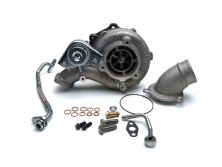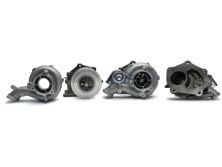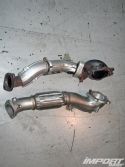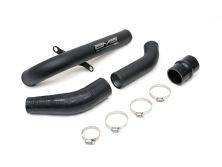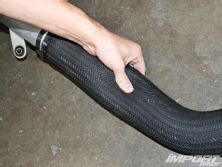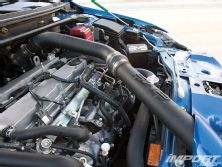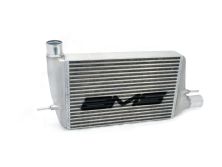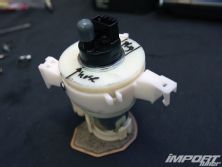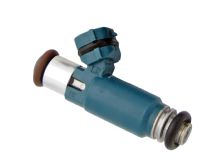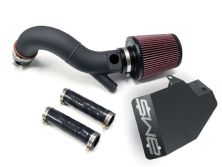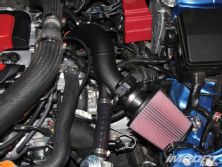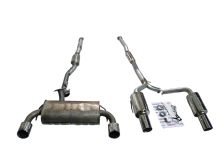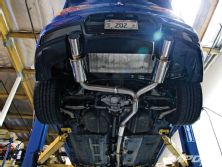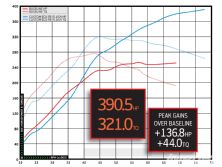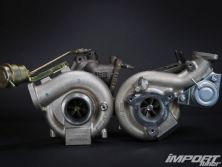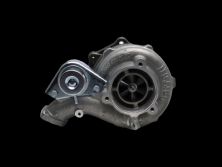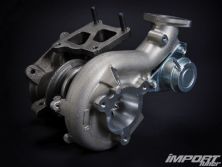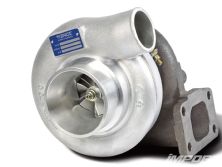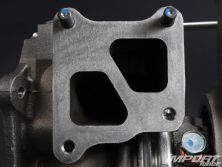Whether it's your car's appearance or how well its engine performs, what you drive says plenty about your personality and the lifestyle you live. For some, it's all about peak horsepower numbers-even if the engine is barely streetable-while others prefer owning the most aggressive wheel offsets known to man, ulta-rare candy-coated paint jobs, and more carbon fiber bits than we care to count. Elliott Moran, better known as "Mr. Super Lap Battle", recently purchased an EVO X GSR with plans to leave it stock. Elliott's motto of "Stock is best!" was his way of evading my questions as I repeatedly harassed him to consider modifying his car. After much discussion and heated debate, we finally came to an agreement and decided on a mix of everyday driving and some weekend competition at the track to build a reliable, daily driven street-car that delivers a significant gain in power over its factory setup. Keeping the car clean and simple with a target goal of 400 whp was our main focus behind this project.
 |
The Ultimate Daily Driven Mitsubishi Evo X - Tech Knowledge
|
The Ultimate Daily Driven Mitsubishi Evo X - Tech Knowledge
Out of the box, the '08 Mitsubishi Lancer Evolution X is a great street performer. Its factory-rated 291hp and 300lb-ft of torque 2.0L mill was engineered to pump out an impressive 145.5 hp per liter of displacement-the largest such rating in its class. Among numerous improvements from the previous 4G63 powerplant, the 4B11 unit uses MIVEC variable valve timing on both intake and exhaust camshafts, whereas the EVO IX only used it on the intake. Coupled with the EVO X S-AWC (Super All Wheel Control) drivetrain which enables all four-wheels to grip the asphalt at seemingly the perfect time, the new car delivers excellent handling. In our first installment with the car, covered in the October '09 issue, we added a set of Tein Monoflex coilovers, 18x10.5-inch Volk RE30 wheels shod in 265/35-18 Continental ContiSportContact3 tires, and a set of 32mm Hotchkis sway bars. With our stock engine delivering 254.2 hp and 277 lb-ft of torque to the wheels, the EVO was able to muster a 2:04.33 lap time around Buttonwillow Raceway's infamous Clockwise 13 configuration, during last year's Super Lap Battle Finals.
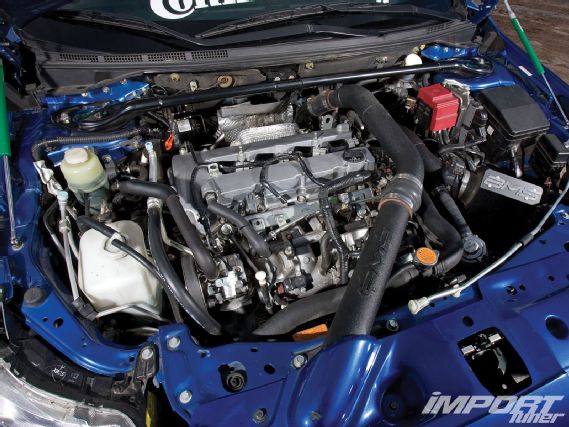 |
The Ultimate Daily Driven Mitsubishi Evo X - Tech Knowledge
|
The Ultimate Daily Driven Mitsubishi Evo X - Tech Knowledge
While a 2:04 lap time is respectable for a street car, it wasn't nearly quick enough to take home a trophy in Super Lap Battle's Street Class. To be considered a truly fast street car, we would need to get under two minutes. Seeing that this is still a daily driven street car, gutting the interior and replacing all the body panels with carbon fiber wasn't an option, and with its brakes already upgraded to Project Mu pads and two-piece APM rotors, the best solution for faster times was to generate more power from the 4B11 engine. To do this, we selected a number of components: Garrett's new GT3071R turbo upgrade; AMS Performance intercooler kit, intake, downpipe; Deatschwerks 800cc/min injectors; a Fujitsubo exhaust; and a custom HB Speed ECU re-flash to coax our EVO over the 400whp threshold.
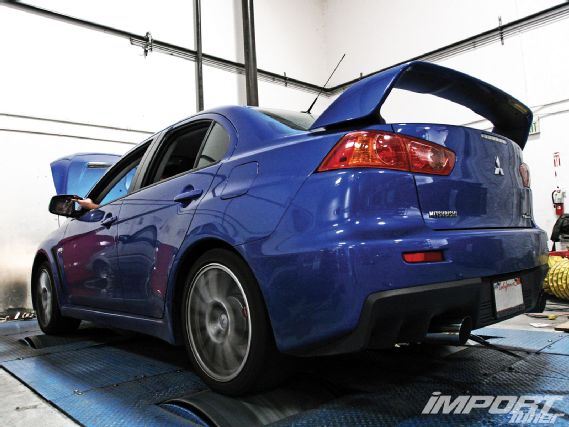 |
The Ultimate Daily Driven Mitsubishi Evo X - Tech Knowledge
|
The Ultimate Daily Driven Mitsubishi Evo X - Tech Knowledge
Garrett's GT3071R turbo, built specifically for the EVO X, is the newest addition to their ball-bearing lineup. Designed for customers wanting something bigger, yet more efficient than stock, the dual ball-bearing GT3071R turbo was designed as a direct bolt-on unit, featuring a specially designed twin-scroll turbine housing that mates up directly to the EVO X's stock exhaust manifold and downpipe, allowing for aftermarket exhausts to be used without worry of fabricating, cutting or welding. The GT3071R features a ported compressor housing to reduce the occurrence of surge during operation, while enabling spool 1,000 rpm faster than the older GT30R, for unmatched power and response. The Garrett turbo upgrade is available in two sizes: the smaller GT3071R which is capable of 475 hp, and the GT3076R which is good for 525 hp. For a custom applications, Garrett offers an optional 2.75- or 4.00-inch turbine inlet, and two available turbine housings in 0.73 or 0.94 A/R sizes-we decided to go with a smaller GT3071R and 0.73 A/R housing for our project. Another benefit to the new Garrett GT turbo lineup is the turbine housing's ability to reuse the stock exhaust heat shield for improved heat control, and a more stealth look.
Since we had to yank the stock turbo out for the Garrett, this was a perfect time to replace the factory O2 housing and downpipe with an AMS "Widemouth" downpipe. Using a CAD-designed cast O2 housing, AMS was able to design the downpipe to their exact specifications for perfect fitment and flow. From flange-to-flange, the downpipe's diameter measures a minimum of three inches. The downpipe and flanges are made of 100-percent cast 304 stainless-steel and includes a secondary bung for use with a wideband O2 sensor.
Straight from the factory, the Mitsubishi EVO is equipped with a corrugated factory rubber inlet and outlet pipe. Why did Mitsubishi do this, you ask? The answer is quite simple. It's an easy, cost-effective design. Unfortunately, this rubber pipe setup has its drawbacks: As your engine increases boost and horsepower, the factory pipes will expand, forcing the turbo to work harder to obtain the same horsepower and boost level. The AMS EVO X intercooler hardpipe kit is a direct replacement for the factory upper intercooler pipe, enabling EVO owners to increase boost pressure and throttle response. Made from lightweight, 2.5-inch, mandrel-bent aluminum tubing, the AMS hard pipe features smooth transitions for maximum performance. Each of its pipe ends are bead-rolled and include mounting provisions to the factory chassis support to prevent couplers from blowing off under boost. All the factory couplers are replaced with quality four-ply silicon pieces which can endure high boost. Available in polished aluminum or black wrinkle-powder finish, we went with the more stealthy black finish.
AMS developed their EVO X intercooler system with the knowledge that significant improvements in heat dissipation and reduction in boost pressure loss can be made when upgrading from the factory tube-and-fin intercooler core to their bar-and-plate unit. Measuring in at 20x12.4x3.5 inches, (32-inches with end tanks and bracket), the AMS intercooler offers over 80 percent more internal area than its stock counterpart, and is designed as a simple bolt-on kit retaining the factory mounting points. The AMS kit fits both the factory intake pipes and aftermarket hard pipe systems, like the AMS hard pipe kit. If proof is in the pudding, you'd be glad to know that the same intercooler core offered to the general public has been tested on their record-setting time-attack EVO X, which is currently churning out 751 whp.
It's a proven fact that when increasing boost, engine's demand more fuel to create more power. With 400 whp in mind, we went to Deatschwerks for a set of their 800cc/min injectors. Deatschwerks uses Denso-manufactured injectors that are statically and dynamically balanced in-house and come with a flow report documenting each injector. The factory-sized 540cc/min injectors were swapped out within minutes, thanks to Deatschwerks' drop-in fitment. Unfortunately, upgrading the fuel pump with a Walbro 255lph in-tank fuel pump wasn't as easy, due to our friends at Mitsubishi deciding to integrate the fuel pump and filter into the same assembly. In need of an adapter to fit the Walbro pump, we contacted HB Speed in Fountain Valley, CA, to install their EVO X fuel kit, consisting of a Duracon fuel pump adapter and fuel line, which enabled the Walbro pump to properly bolt in place of the factory fuel pump/filter assembly. HB Speed also replaced the EVO's factory plastic hose from the fuel pump to the stock line, which have been known to become brittle and deteriorate over time-more so when using corrosive fuels like Ethanol.
The factory intake on the EVO X comes with a built-in snorkel-a modest attempt to ingest cold air, but its performance is nowhere near as efficient as the new AMS Performance Intake. The AMS intake uses a three-inch, mandrel-bent aluminum pipe that not only improves the rather bland-looking engine bay, but has the performance numbers to back it up. Each end of the pipe has been bead-rolled, while a four-ply silicone coupler keeps the unit securely in place. The factory bypass valve has been cleverly relocated inline with the airflow to minimize turbulence. As an added feature, we installed an AMS intake fan shield to prevent erratic idle caused by the A/C fan blowing hot air into the MAFS when using an aftermarket intake.
The JDM-spec RM01A exhaust is comprised of a stainless-steel 70mm mid-pipe, splitting off into dual 60.5mm pipes, before terminating at the exhaust canisters. An integrated silencer keeps decibel levels within legal limits for California usage. Decibel testing with the factory catalytic converter installed revealed the RM01A emitting 72 dB at idle, in comparison to the factory exhaust which produces 64 db. At 4,850 rpm, the Fujitsubo exhaust registered 92 dB, while the stock exhaust was recorded at 86 dB. At only 6 dB higher than the factory exhaust, the RM01A offers performance gains without exhibiting an overbearing tone that attracts local law enforcement when driving on the streets-no wonder it's considered by many EVO X owners as the most street-friendly exhaust sold in Japan. It's available as a special-order unit though Tein USA.
After spending countless hours behind the wrench, we installed our parts and took the car to Jon Drenas at HB Speed for a tuning session. Rather than using an expensive stand-alone fuel management system, we opted to go with a reflash program, because of the car's daily driven status. We took enjoyment in knowing the re-flashed ECU ensures our EVO X will retain use of all of its factory faculties; should the engine overheat or any of its sensors fail, the factory ECU can safeguard against damage. Having tuned numerous EVO Xs, Drenas mentions how upgrading the down pipe, intake, and turbo on an EVO X without proper tuning can cause the 4B11 to run excessively rich, minimizing horsepower gains. "The most common issue with tuning an EVO X is making sure the fuel trims are accurate to ensure the engine doesn't run overly lean or rich air/fuel ratios, which can affect the car's performance at open throttle," he warns.
Jon was able to create a custom ECU map, after which the EVO X made 391 whp and 321 lb-ft at 25 pounds of boost-a gain of 136.8 hp and 44 lb-ft of torque over our baseline dyno run. Although we barely missed our projected 400whp target, keep in mind that our final dyno number was accomplished with the stock catalytic converter still in place, as well as running on California's crappy 91-octane fuel.
PRICE BREAKDOWN MSRP Garrett GT3071R Turbocharger $2290.00 Deatschwerks 800cc/min Injectors $399.00 AMS Front-Mount Intercooler $759.95 AMS Upper Intercooler Pipe $339.95 AMS Performance Air Intake $349.95 AMS Intake Fan Shield $49.95 AMS "Widemouth" Downpipe $459.95 Fujitsubo JDM spec RM01A Exhaust $1440.00 Walbro 255lph Fuel Pump $89.00 HB Speed Fuel Pump adapter $150.00 HB Speed Dyno Tuning $450.00 Total: $6777.75
With 391 whp on tap, the car made its return to Buttonwillow Raceway for 2NR's own EVO vs. STI Shootout and Super Lap Battle Finals (May '10 issue), and we got to see if its power upgrades could deliver a significant improvement to our previous lap time. With a sub-two-minute lap time being our goal, we asked driving ace Robert Walker to pilot our EVO. No slouch when it comes to driving, Rob is the current Super Lap Battle Street FR record holder, with a 1:56.7 best time in the Evasive S2000. In his first session behind the wheel of our newly upgraded EVO, Rob was able to clock a 2:00.691 lap, just shy of our goal. Unfortunately for us, Rob had signed on to drive a handful of other cars throughout the day, and didn't get to take ours back out, so we'll never know if modification thus far added would've been enough to realize our goals. With a few more adjustments to the suspension, along with adding a larger, more aggressive rear wing for additional down force, we're certain coaxing a 1:58-1:59 second time would easily be within reach. Stay tuned as we continue our quest for a fast, true street car that sees more time sitting in SoCal traffic driving back from a track, than it does sitting in a trailer en route to one.
 |
The Ultimate Daily Driven Mitsubishi Evo X - Tech Knowledge
|
The Ultimate Daily Driven Mitsubishi Evo X - Tech Knowledge
Why did Mitsubishi use a twin-scroll turbine on the EVO X instead of a single-scroll unit? To answer this question, we analyze both the single-scroll and twin-scroll turbine system, resulting in some interesting finds.
The twin-scroll turbo uses dual side-by-side passages built into the housing, while the more commonly used single-scroll design uses only one. A twin-scroll turbine's housing is designed to separate the exhaust gas pulses of cylinders 1 and 4 from those of cylinders 2 and 3. Due to the firing order of the EVO X's 4B11 engine (1-3-4-2), the exhaust pulses alternate to create higher backpressure at lower rpm into the turbine wheel from each divide, enabling a quicker spool-up. Single-scroll turbos are less effective in using exhaust pulse energy to help spin a turbine wheel up to speed. Twin-scroll turbines also work more efficiently by delivering lower backpressure at high rpm, allowing cylinders to expel the exhaust gases without as much interference with incoming intake charges, creating improved top-end performance.
Comparing both turbos, the twin-scroll setup with its more efficient exhaust gas scavenging abilities clearly has the advantage, allowing for improved throttle response, quicker spool-up, increased fuel efficiency, and ultimately more power throughout the rpm range. But with any car, selecting the correct turbo size and supporting mods for your engine becomes the determining factor on how efficient your vehicle performs, regardless if you're using a single-scroll or twin-scroll turbine.
EVO IX EVO X EVO X TURBINE TD05HR-16G6C-10.5T TD05H-152G6-12T GARRETT GT3071R COMPRESSOR WHEEL INDUCER 49.24 MM 47.99 MM 53.1MM COMPRESSOR WHEEL EXDUCER 68 MM 68 MM 71 MM COMPRESSOR WHEEL TRIM 50 48 56 COMPRESSOR HOUSING A/R 0.50 0.50 0.6 TURBINE WHEEL DIAMETER 56 MM 56 MM 60.0MM TURBINE HOUSING A/R 10.5 CM2 12 CM2 0.73

